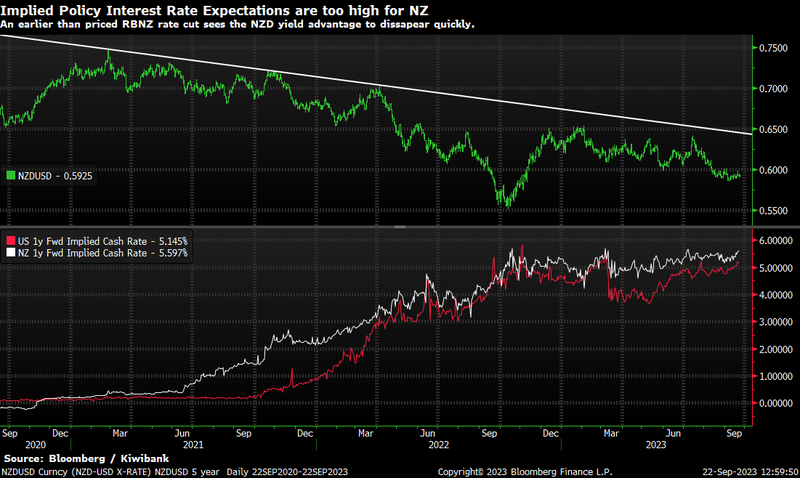
- The Kiwi has fallen against the Greenback, as expected. Our forecast for the Kiwi is sharply unchanged at 55c by year end. If it ain't broke, we won’t fix it. We have grown in our conviction. Falling commodity prices, narrowing interest rate differentials, and weakening risk appetite should see it through.
- In our last FX tactical in June, we reiterated our expectation for a weakening in the Kiwi. Importers beware. Against the other crosses, the outlook gets murky. We provide our thoughts on the GBP, Euro, Yen, and the Aussie.
- Interest rates have peaked in Aotearoa, as they are still rising offshore. We stick out, calling for cuts. But that’s the risk.
In our last FX Tactical in June, we wrote “There is not a lot of upside in the tarot cards for the Kiwi”. Three months later, and our tarot readings have materialised. We expected the Kiwi to face plenty of downside pressure. And so far, this has been the case. Risk appetite is weakening, commodity prices are falling, and the Fed, the world’s most influential central bank, maintains the mantra of ‘higher rates for longer’. The Greenback has benefited from its safe haven status, and the Kiwi flyer has struggled to gain airspeed.
Not only were we right in the direction, but our target forecasts were not too shabby either. “Our pick is that the Kiwi will head towards the 0.5700 level before the year is out, but it won’t be in a straight line. First off the bat we will need to crack the 0.5900 level.”(FX Tactical, June 2023). And here we are with a Kiwi that’s fallen from a high of near 64USc to ~59USc in the last three months. And 55c is still waiting at the year-end finish-line.
We also pointed out that we didn’t see the move happening in a straight line. We are still seeing some shorter-lived boosts to the Kiwi, largely related to the Greenback and risk sentiment. While there have been considerations from traders, that a big revaluation of the US Dollar is now due, the hawkish tone maintained by the Fed is providing support for the Greenback in the short to medium term. Cuts from the Fed are now forecast to be further out into 2024/2025.
The fundamentals are still in play for a weaker Kiwi. Two key factors are falling commodity prices, and the lagging Chinese economy. In addition, the outlook for the local economy is not looking too bright. Our most recent (June quarter) economic report showed that the Kiwi economy climbed its way out of a technical recession – but only by a hair’s breadth. Despite the stronger starting point, we are still expecting further softening in activity over the coming quarters. And again, that’s not good news for the Kiwi.
Interest rate differentials are a key driver for any pair of currencies. And who sets interest rates? Central banks. With 525bps of rate hikes under its belt, we believe the RBNZ is done with a “very, very high bar” for further increases. The RBNZ was among the first to raise rates, post-Covid. It’s likely they could be the first to cut rates next year. The RBNZ’s international peers, however, may have more left in the tank. Again, that will work against the Kiwi.
Our forecast for the Kiwi is sharply unchanged at 55c. If anything, we have grown in our conviction. Falling commodity prices, narrowing interest rate differentials, and weakening risk appetite should see it through.
The Greenback.
Inflation in the US has fallen from 9.1%, at its peak in June last year, to just 3.7%. That’s a fantastic achievement, but it’s not yet back at the 2% target. Hold the champagne. Unfortunately, upside risks for inflation remain. Especially with the recent jump in oil prices. Inflation is now slowing more gradually, and remains widespread. The continued wage pressures given a still-tight (but loosening) labour market doesn’t help either. The Fed sees the need for further tweaking. And their hawkish stance was on full display at the September policy meeting. Rates were kept unchanged, but the new projections still have another hike by the end of this year as well as less easing next year. The surprise upward revisions from the Fed will see a stronger US Dollar, and further downside in the Kiwi. The Fed are clearly sticking to their ‘higher for longer’ story, whereas we see it to be quite likely that the RBNZ will need to cut rates sooner. And if the Fed hold for a long time, compared with our likely cuts… that rate story will see Kiwi lower. Not to mention the fundamentals that would have necessitated a cut from the RBNZ in the first place.
The Yen.
Over in the Land of the Rising Sun, recent moves have been popcorn-worthy, to say the least. The Bank of Japan (BoJ) has long been an outlier in the current interest rate environment. Going against their peers, they’ve stuck to their rigid yield curve control (YCC) and negative interest rates to provide monetary stimulus. However, recent talk from officials would seem that it’s possible the YCC will be removed in the near future, potentially later this year. Unwinding the negative interest rate policy, on the other hand, is unlikely in the near term. But we still think it’s coming – it’s more a matter of when. And when this ‘normalisation’ from the BoJ does hit, it will see the Yen revalued considerably higher. Recent moves in the Yen have given us a flavour of what’s to come. Recent rhetoric from BoJ officials opining that the Yen is undervalued have seen a few brisk moves for USDJPY in particular. For the Kiwi traders playing in this space, we see the first downside target for NZDJPY to be 85.06. 83.97 and then sub 80.00.
The Pound and the Euro.
We have seen some interesting moves for NZDGBP of late. The Pound has arguably been slightly overvalued given the fundamentals in their economy. The macro picture of the UK economy has been mixed and middled. Cracks are clearly emerging in their economy and unemployment has substantially increased since the beginning of the year. However, inflation remains high and wage growth
continues to soar. And on balance, wage-prices spiralling out of control is the bigger concern. There’s a clear need for the Bank of England to continue tightening. On Thursday night, the BoE decided to pause for breath, at 5.25%, after 14 straight rate hikes. Softness in the housing market, and a downward revision to growth estimates seemed to dominate. The decision was the narrowest of margins, with 5-4 voting in favour. 4 members voted for another hike to 5.5% - the highest in 15 years. "Further tightening in monetary policy would be required if there were evidence of more persistent inflationary pressures," BoE. If delivered, a 5.50% cash rate in the UK would be on par with the RBNZ cash rate, for the first time since late 1990s/early2000s. The potential for the BoE to continue tightening has given the Pound some wings, to a point.
As for the Euro, it is looking more like the ECB are done with their tightening cycle for now. But much like the Fed, they have kept the door open for future rate hikes to ensure there is not an unwind of their hard work with a rally in the rates market.
Our views for the Kiwi dollar against both of these currencies is fairly neutral. We will be range bound, at least for the short-to-medium term.
The other Antipodean dollar.
Similarly, we also have more of a neutral view for the NZDAUD currency pair. The RBA are clearly done with rate hikes but looking for a guide on where potential cuts may come through from the RBA is a little more difficult. We certainly think the RBNZ will go first with cuts, so this should be NZDAUD negative. The China growth (or lack thereof) story will remain a driver here also. And every time there is an improvement in financial market risk sentiment – be it a positive snippet of news or upward revision to data expectations – the Aussie dollar will outperform the Kiwi. Falling commodity prices will also likely be a drag on both currencies. However, the Aussie economy is ultimately in better shape than NZ. So, this needs to be a factor considered. Therefore, our bias is a slightly lower Kiwi vs Aussie.
Kiwi crosses in the months ahead
NZDUSD (3-year daily)
Stick to the plan, its working! As anticipated in the last tactical, NZDUSD navigated its way nicely into the 61.8% ‘golden pocket’ retracement of the 0.5512-0.6538 rally at the 59-cent mark. Unsurprising to witness some consolidation around current levels given oversold momentum indicators (note the RSI indicator below) and NZDUSD running into a channel support level. Won’t be surprised to see possible rallies even towards 0.6150 within the next quarter, but ultimately the trend remains your friend with our downside target into the double bottom at 55-cents still preferred. This view would be abandoned with a breach of the broader channel resistance currently around 0.6450 – hard to envision within the current interest rate environment.
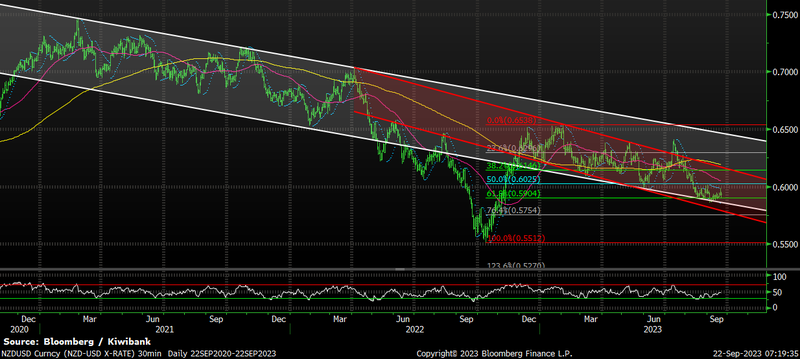
NZDJPY (2-year daily)
The market continues to wait for BOJ action. In a bearish narrowing wedge pattern, an ultimate break below the April 2023 trend support area of circa 86.90/87 currently - perhaps on the removal of BOJ YCC / stimulus sees risk of a move initially into July’s low and 50% retracement level of 80.43 – 89.69 at 85.06. From there the 61.8% retracement at 83.97 becomes a looming target. That said, should 2024 dynamics lead to BOJ tightening and RBNZ loosing, do not be surprised to see NZDJPY test the 80 cent handle by mid-2024. If the BOJ continue hold off in loosing policy, top side targets are defined towards 90.00 – although the air is very thin up here.
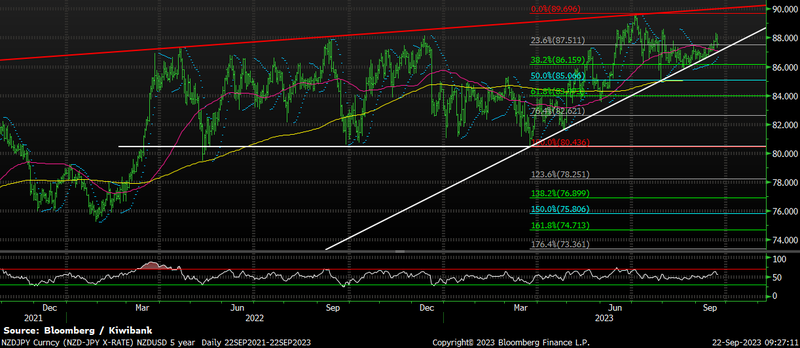
NZDAUD (5-year daily)
Wake me up when we see interest rate policy divergence. Despite ongoing noise of economic troubles in China, investors have largely treated NZD and AUD in the same basket over the last quarter. Technically the picture is narrowing triangle which can help provide shorter-term direction indicator once breached – but ultimately interest rate fundamentals, when they develop, most likely in 2024 will bring about the bigger moves. For the quarter ahead, expect a continued narrowing of the slightly bullish ascending triangle pattern below currently seeing support at 0.9170 and resistance up to 0.94. Typically, ascending triangles are a bullish indicator, however in the below instance the triangle is perhaps more closer to symmetrical than ascending with a strong trend resistance in its way. Nonetheless, watching the 0.9170 and 94 cent marks to determine direction from that point, but we still ultimately favour a downside move eventually to play out.
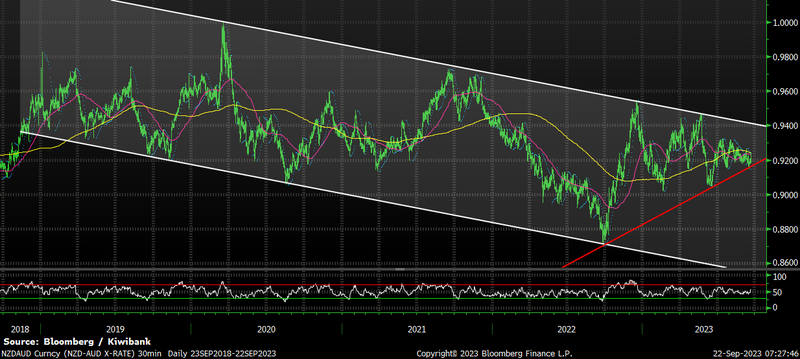
NZDEUR (5-year daily)
The bearish “descending triangle” pattern did ultimately give way in the last quarter seeing moves into the 0.5430 region. Recent NZ Dollar support and market expectations of the ECB moving towards a slightly less hawkish stance has seen NZDEUR put in a recovery over the past few weeks. A test now looms at current levels (0.5560/70) and then more significantly into 0.5610. EUR buyers should consider this area for shorter-medium term requirements. Downside targets exist at the 0.5430 low and then into the high 53’s. The pattern remains bearish until the 200-day moving average (yellow line – circa 0.5710 currently) is breached.
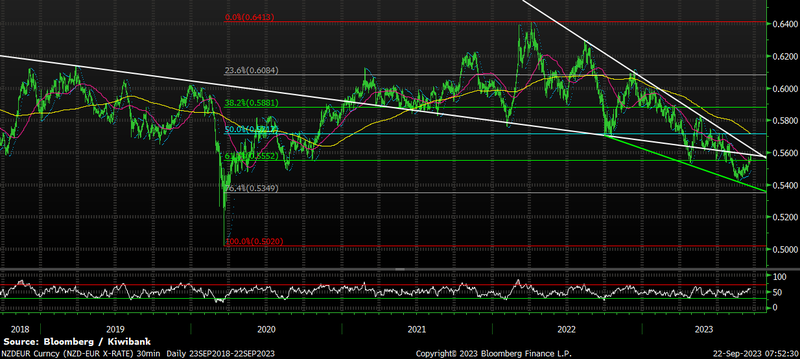
NZDGBP (5-year daily)
A hot off the press surprise BOE hawkish hold at this week’s policy event sees a test of the 2023 channel resistance. A relief rally was always on the cards as the BOE come closer to the end of its hiking cycle. Technically from the 0.4632 lower, the RSI momentum indicator was at oversold levels. In the blink of a few weeks, the same indicator sits close to an overbought reading. The BOE still has a bigger task than other major economies in firmly bringing inflation back into target and as such we won’t be surprised to see further hikes or at the very least a longer than RBNZ hold at current levels. As such, GBP buyers should consider this nice pop higher with an expectation of a consolidation back towards the August low in the coming quarter.
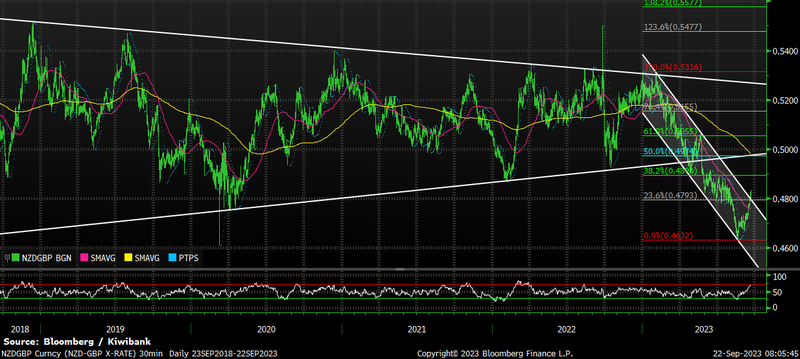
Glossary
Commodity currencies: include the Kiwi dollar, Aussie dollar, Canadian dollar, Norwegian krone as well as currencies of some developing nations like the Brazilian real. These countries export large amounts of commodities (raw materials like oil, metals and dairy) to the world. And commodity currencies are highly correlated with the global prices of such commodities. When the global economy is strong and demand for commodities is high, commodity prices and thus commodity currencies, tend to outperform. The Aussie and Kiwi dollars are famously known for the sensitivity to good news (risk on) and bad news (risk off).
Interest rate differentials: The difference between the interest rates earnt on two different currencies. New Zealand may offer a significantly higher interest rate than those in Japan, for example, and we see an inflow of Yen into Kiwi dollars (known as the “carry trade”). The widening, and narrowing, of interest rate differentials can have a material impact on capital flows and therefore the exchange rate.
Monetary hawk (hawkish) and Monetary dove (dovish): Characterisations of central bank monetary policy. The hawk is a bird of prey and describes a central bank aggressively raising interest rates to slow economic growth and tame the inflation beast. The peace-loving dove however, reflects a central bank trying to stimulate economic growth by cutting interest rates.
Moving averages: A common method used in technical analysis to smooth out price data by showing the average over various time periods.
Reserve currency: The US dollar is the global reserve currency. The dominance of the US dollar in international trade means most central banks and financial institutions hold large amounts. The majority of FX reserves are held in US dollars. The US currency and debt markets are the most liquid in the world. And liquidity (the ability to buy and sell, especially in times of stress) is important. The next most traded currency is the Euro, but it is nowhere near as popular as the US dollar. About 60% of global reserves are held in dollars, with the Euro attracting only 20%, according to the IMF.
Safe haven currencies: A safe haven currency is one where investors hide from extreme market turbulence. The US dollar tops the list of safe haven currencies. But the Yen and Swiss Franc are also beneficiaries of save haven flows (money searching for safety). If a war breaks out tomorrow, we’re likely to see a spike in the USD, Yen, and Swiss Franc. The Kiwi dollar would be hit quite hard, and fall against these three currencies. Gold is also considered to be a safe haven asset during times of stress.
Support and Resistance levels: These are chart levels that appear to limit a currency’s price movement. A support level limits moves to the downside; a resistance level limits moves to the upside.
Terms of trade: The ratio of the prices at which a country sells its exports to the prices it pays for its imports. Put simply, terms of trade is a measure of a country’s purchasing power with the rest of the world. How many imports can be purchased per unit of exports – import bang per export buck. An increase in our terms of trade means New Zealand can purchase more import goods for the same quantity of exports. And a rising terms of trade lifts the incomes of exporters and the businesses and communities that support them.